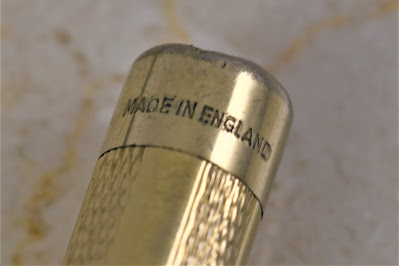This article has been included in The Leadhead's Pencil Blog Volume 7, now available here.
If you don't want the book but you enjoy the article, please consider supporting the Blog project here.
The fascinating thing about collecting Eversharps is how many variations there are, many of which are so subtle than even when you are fully alert and on your toes, things can slip right by unnoticed. Matt McColm tipped me off about this one in an online auction:
I’ve got one of those, I said. “Ring Colonial,” Wahl called the pattern . . . I hadn’t checked my stash before I made that assessment, though, so I didn’t know at the time that the only other example I had in this pattern was the side clip model:
However, that wasn’t what changed my mind – it was Matt’s incredulous response: "With that cap?” he asked:
Now that was something I knew I didn’t have – I had already done a full inventory specifically looking for different caps just a few months ago, when I was looking for other examples of that deco cap that turned up on a Grecian Border example (Volume 6, page 25):
Well, heck – you’d think Eversharp would use the cap with a grecian border on the Grecian Border pattern, not the Ring Colonial! Matt went on to explain that this variation is illustrated in Wahl’s catalogs, so I went to the PCA library to check. There it was, in the 1928 catalog:
Shown on both the side clip and ringtop versions of the Ring Colonial . . . and not any other pattern:
Two Eversharps in Don Jacoby’s collection also had subtle little differences that nearly got past me. The first was in a drawer full of metal pencils;
An Eversharp in a common pattern like this, and with a name engraved on it, wouldn’t make headlines in a sea of other pencils . . . but when I picked it up for a closer look, what makes it unusual stands out:
This is a full length model with no clip. I’ve only found one other like it:
These two both have the same imprint: “Ever Sharp,” two words, with no mention of The Wahl Company; that dates the pencils to a period between the pencil’s introduction in 1913 and shortly after Wahl took over production of the pencils and began making them on Wahl’s own account in 1917.
To my knowledge they have never been found mentioned in any Wahl catalogs, and I’ve never seen them pictured in any advertisements, either.
It could be that these were made very shortly after Wahl started making pencils for Charles Keeran in October, 1915. Earlier Ever Sharp pencils were made by the George W. Heath Company, and they sported Heath’s patented clips – if the Heath relationship ended badly, perhaps Keeran and Wahl were left without any clip to use until Keeran took out his design patent for the “trowel clip,” which was soldered to the side of the barrel. Both the Heath clip and later Wahl clip models required punching holes in the barrel before the inner liner was inserted; only the trowel clip model of 1916 would have had a barrel free of punches.
It’s just a theory. I wasn’t there.
The other one from Don’s collection is an eye-roller for Eversharp collectors:
We know we are supposed to like and appreciate these, but they just aren’t all that attractive . . . they were made after Parker acquired parts of Eversharp in 1957, we know because they sport the “Big E” on the clip and the later script Eversharp logo near the top:
As was the case with the other pencils I’ve seen along these lines, it has a “Made in England” imprint:
I grudgingly opened the drawer containing my other examples, just to see if it was different from what I’ve found so far:
It is. The other examples are even uglier, with triangular lower barrel sections that are larger than the tops. The barrel on Don’s pencil is round, but that’s not what’s really different here. Two of these awkward-looking pencils are cap-actuated repeating pencils, which advance the lead by pushing down on the cap. The third is a rear-drive twist pencil:
Don’s pencil, however, is a nose-drive twist pencil:


















No comments:
Post a Comment